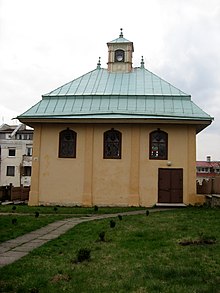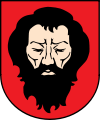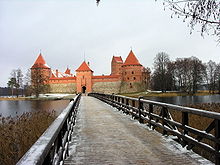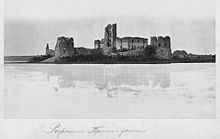Trakai
| Trakai | ||
|
||
| State : |
|
|
| District : | Vilnius | |
| Rajong municipality : | Trakai | |
| Coordinates : | 54 ° 39 ′ N , 24 ° 56 ′ E | |
| Height : | 155 m | |
| Area (place) : | 11.52 km² | |
| Community area : | 1,208 km² | |
| Inhabitants (place) : | 4,298 (2018) | |
| Population density : | 373 inhabitants per km² | |
| Inhabitant (municipality) : | 32,744 (2017) | |
| Population density : | 27 inhabitants per km² | |
| Time zone : | EET (UTC + 2) | |
| Postal code : | LT-21001 | |
| Status: | City and seat in the district of Trakai | |
| Structure : | 8 offices | |
| Mayor : | Vincas Kapočius |
|
| Website : | ||
|
|
||
Trakai (German older Traken, Polish Troki, Yiddish Troke ) is a city and seat, but not the largest city of the Rajongemeinde Trakai in Lithuania . The city has (2018) 4,298 inhabitants and an area of 11.52 km².
geography
The city is located 28 kilometers west of Vilnius , the Lithuanian capital . There are 200 lakes in the area. The place is famous for its old water castle Trakai on an island between the Galvesee , the Lukasee and the Totoriskesee . The Galvesee with its 21 islands is the deepest lake in the region at 46.7 m. Its area is 3.88 km².
population
Today, in addition to Lithuanians, there are not a few ethnic Poles in Trakai , as well as Russians , Belarusians , Karaites and Tatars. The population has decreased by around 2500 people since the country gained independence.
| local community | city | |
|---|---|---|
| Residents | 32,744 (2017) | 4,298 (2018) |
| from that: | ||
| Lithuanians | ~ 53% | ~ 60% |
| Poland | ~ 33% | ~ 20% |
| Russians | ~ 8.5% | |
| Belarusians | ~ 2.3% | |
| Karaites | ~ 0.2% | 65 |
Around 65 of the 257 Karaeans (or Karaimen) counted in Lithuania live in Trakai . Trakai is the cultural and religious center of the Karaimen Jewish stream and older residents in particular speak the Karaim language ( Turkic language ) in the local Northwest Karaim dialect variant. This dialect was formed primarily through adjustments to the languages of the surrounding languages, namely through a very pronounced takeover of pronunciation peculiarities, words and grammatical structures from Lithuanian , Polish , and then Russian . There was also an influence that was not entirely clear through contact with East Yiddish .
history

Old Trakai was the capital of the Grand Duchy of Lithuania for seven years from 1316 to 1323 in the Middle Ages . Legend has it that Gediminas was on a hunt, found a beautiful hill in the forest in the area and moved the capital from Kernave here. Trakai was mentioned in a document in 1337.
The 13th and 14th centuries were marked by battles against the crusaders of the Teutonic Order . During the second half of the 14th century, a stone castle was built in Old Trakai, the temporary residence of the Grand Duke. At the end of the 14th century the castle was destroyed and not rebuilt. A neo-Gothic church was built in its place in the second half of the 19th century. The remains of a Benedictine monastery can be seen in the vicinity. There was the Traken District in the Traken Voivodeship of the Grand Duchy of Lithuania.
Neu-Trakai, today's town of Trakai, is three kilometers from the Alt-Trakai castle complex. The city of Trakai could not expand after the Middle Ages due to its location between the lakes.
Cityscape
The area of the old town is 169 hectares and is one of five old towns in Lithuania under the protection of the state. The city is worth seeing for its unique geographical location and wooden architecture. The urban structure is extraordinary - linear in summer (the city stretches along the lake), radial in winter (you can use the frozen lakes as paths). The main road crosses the entire peninsula on which the city is located.
The former market square is marked by the chapel column with the sculpture of St. John Nepomuk . Nepomuk is the patron saint of fishermen and towns on the water (18th century).
A blue house can be seen next to the market square, which is the building of the old post office. It was built by Dominicans . Today it is used by the administration of the Trakai Historical National Park .
The Dominican monastery was closed at the end of the 19th century. After that, the building survived many conversions (from the monastery to the KGB branch). Today it houses the administration of the Trakai Historical Museum.
Not far from the hill is the Basilica of the Visitation of the Virgin Mary . In 1409 it was donated by Vytautas the Great as a parish church. It used to be part of the Traka City protection system. It was built in the Gothic style. The church was rebuilt in the 17th and 18th centuries. The facade and the interior decoration show features of the Gothic and Baroque. She is known through the image of Our Lady of Trakai. At the beginning of the 18th century, the virgin depicted in the picture was crowned the patron saint of Lithuania with a golden crown given by the Pope. In 2017 she became a minor basilica.
A quarter with wooden houses has been preserved on the northern side of the city. It is one of the most important historical elements of Trakai. Karäerstrasse is the continuation of Vytautas Street, which connects the Christian with the so-called "Little Town". The small town was settled by Tatars and Karaites. The Karaitic kenessa dates from the 18th century. As an ethnographic attraction, the quarter of one-story wooden houses is under the protection of the state. The houses face the street with their gables and have three windows: one window is dedicated to God, the second to Vytautas, and the third to oneself.
The Trakai District Court (court of first instance) has its seat in the city .
Castles
The two castles are the most architecturally significant defense complex in Lithuania. The founding of the city in the 13th century coincided with that of the Lithuanian state. The newly established state had to withstand invasions from Christian Europe for 200 years. The knights tried to avoid the area, the castle team was invincible to them.
Peninsula castle
In the crusader chronicle it is reported that this is the new castle of Trakai. The old wooden castle was replaced by a stone one.
In the height between two lakes - Bernardinu and Galves - stood a peninsula castle, which was separated from the city by a wall and a deep moat. The castle was protected by eleven defense towers. It was attacked several times - not only by the knights of the order, but also damaged by internal wars between the princes of Lithuania. After the Tannenberg Battle in 1410, work began on rebuilding the castle. However, after the death of Vytauta the Great, the work was not finished. In the 18th century, members of the Dominican order came here who had built a monastery and a chapel here. Later it was finally destroyed. Restoration work was not carried out until the second half of the 19th century.
Today the peninsula castle is known for the traditional medieval festival. Life in the Middle Ages is presented through craftsmen and knight fights.
Stairs lead to the Auku mountain (sacrificial mountain). Legend has it that pagan rituals were performed here and sacrifices were made to the gods. In the second half of the 20th century, the remains of the never completed 15th century palace were discovered.
Inselburg
In 1414 the Flemish knight Ghillbert de Lanois (Lanua) characterized the castle as follows in his travelogues: the castle stands in the middle of the lake, a cannon shot from the old castle. It is a brickwork, built according to French tradition. The castle stood 220 m from the shore.
The castle consists of two main parts:
Princely palace in the form of a U
Construction work began on the palace. At the beginning of the construction the castle was burned down. Later it was surrounded by the wall with buttresses erected on the edge of the island. A deep ditch with lake water separated the palace from the outer bailey.
Two oval wings from the palace were connected by a six-story keep .
The keep has a square floor plan and has become the main accentuation of the castle: the entrance to the courtyard is on the first floor, narrow and high. The only way to get into the courtyard was via a movable bridge and an iron grille. The guard had its rooms on the second floor. The chapel for the royal family was built on the fifth floor. The loopholes can be seen on the sixth floor.
The castle was last attacked by the Crusaders in 1403. After the Battle of Tannenberg, the attacks came to an end.
The palace is conventional, with three floors. Two almost symmetrical wings are surrounded by a wooden terrace. The masonry is made of stones and bricks of various sizes and has Romanesque and Gothic features. The rooms are equipped with the typical Gothic vault, the pointed arched windows are decorated with bricks in 15 shapes, the mortar was mixed from lime, sand and clay.
Outer bailey
That was the second stage of the construction work. Casemates and towers were also built at the same time . The outer bailey, in the shape of an irregular trapezoid, was surrounded by a wall with three towers at the corners. A prison was set up in the southwest tower. The lower part of the towers is square, the upper part round, the towers protrude to the outside. The masonry on the city side is thickest. In the outer bailey, the townspeople were able to take shelter during the attacks. The casemate rooms can be seen on the western side. The castle crew lived here, and utility rooms are on the other side.
The yard
An air heating system was installed in the base floor. The hot air rose through the tube and in this way the brick floor was heated. Each wing on the floor has three rooms. The princely living quarters were set up in the left wing of the second floor. Only the two rooms of the prince and princess were connected with a door.
The great hall
The Gothic portal, vitrage, wall painting - in 1822 the painter Smakauskas fixed fragments, good acoustics, tapestries (from the present). The height of the rooms - 5.5 m, 20% original masonry.
Vytautas was educated, could speak German, Latin and Russian, and also understood Tatar. He was very hospitable but did not drink alcohol himself.
The frescoes depicted the life of the prince in the palace. Famous European statesmen, such as B. Ambassador of Venice, Magister of the Livonian Order and Order of the Cross.
Ona, the wife of Vytautas accompanied her husband on his travels, she could read and write. Her wardrobe was very extensive. The master of the order has sent her presents. Chess was played here and large festive banquets were held.
The museum has a total of over 300,000 exhibits.
In the 19th century, the castles were gradually destroyed by people and time. Efforts were made to restore the castle at the beginning of the 20th century. But it was not until 1955 to 1987 that the architects Bronius Kruminis and Stanislovas Mikulionis gave the castle its overall appearance from the 15th century.
Town twinning
Trakai lists the following 15 twin cities :
| city | country | since |
|---|---|---|
|
Acre |
|
2015 |
|
Alanya |
|
2006 |
|
Avola |
|
2015 |
|
Bernburg |
|
|
|
Borne |
|
|
|
Giżycko, town (Lötzen) |
|
2005 |
|
Giżycko, land |
|
2013 |
|
Ivano-Frankivsk |
|
2006 |
|
Jaroslaw |
|
|
|
Yes, yes |
|
|
|
Kondopoga |
|
2014 |
|
Lida |
|
2008 |
|
Lutsk |
|
2010 |
|
Malbork (Marienburg) |
|
1997 |
| Mtskheta |
|
2014 |
|
Nowy Sącz (New Sandez) |
|
|
|
Polatsk |
|
2004 |
|
Qazax |
|
2017 |
|
Rheine |
|
1996 |
|
Schönebeck |
|
2003 * |
|
Târgovişte |
|
- * Letter of intent
education
- Police School of Lithuania in Trakai
- King Mindaugas Vocational Training Center
- Boarding sports school Trakai
sons and daughters of the town
- Sofia of Lithuania (1371–1453), Grand Duchess of Moscow
- Isaak Troki (around 1533; † around 1594), Karaite
- Wladimir Belski (1866–1946), Russian librettist
- Mykolas Firkovičius (1924–2000), Lithuanian-Karaean poet and Chassan of the Karaites
- Laurynas Mindaugas Stankevičius (1935–2017), politician and Prime Minister of Lithuania (1996)
- Halina Kobeckaitė (* 1939), diplomat
- Romualdas Kozyrovičius (* 1943), civil engineer and diplomat
- Algirdas Vaclovas Patackas (1943–2015), politician
- Jadvyga Zinkevičiūtė (* 1949), politician
- Jarosław Narkiewicz (* 1962), Lithuanian politician of Polish origin
- Edward Trusewicz (* 1979), Lithuanian politician of Polish origin
- Povilas Čukinas (born 1983), basketball player
See also
Web links
- Official website of the city of Trakai (Lithuanian, English, German, Russian)
- Lithuania Infobase: Pictures from Trakai
- Trakai: city, island castle, national park, picture gallery.
Individual evidence
- ↑ Trakų rajono savivaldybė - Miestai partneriai. Retrieved April 25, 2019 .












